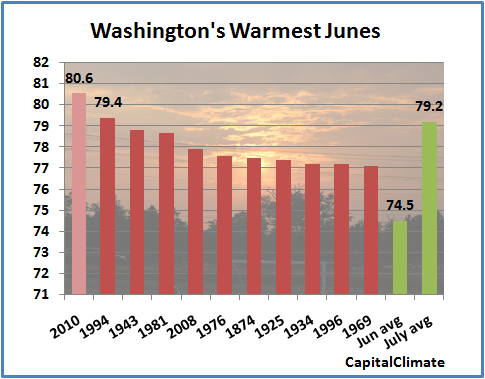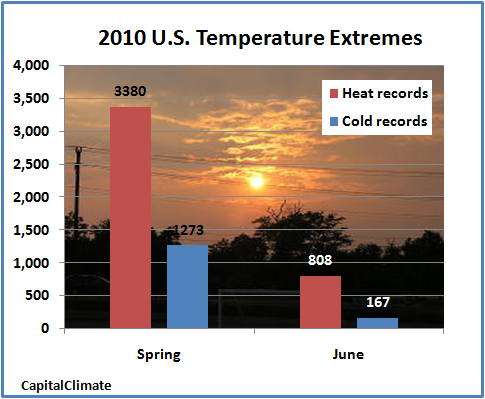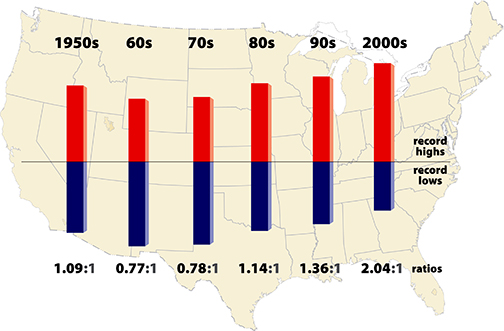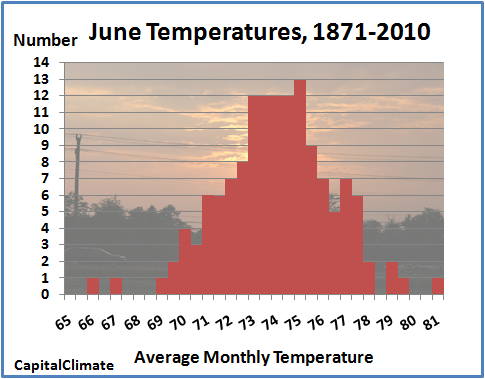“We’re getting a dramatic taste of the kind of weather we are on course to bequeath to our grandchildren,” says Tom Peterson, Chief Scientist for NOAA’s National Climatic Data Center.
An “excessive heat warning” has been issued this week for parts of the East Coast, home of the status quo media, so please send me examples of coverage – good or bad. Also, drink plenty of fluids and stay cool!
I got a call last week from a Florida reporter. Did I know that it was so hot that Miami set the all-time monthly temperature record in June? Was all the strange weather part of some longer-term pattern?
No and yes. He directed me to the National Weather Service summary for Miami here. And I pointed out to him that NASA reported that globally it was easily the hottest spring – and Jan-May – in the temperature record (and NOAA, too).
Record-smashing temps are precisely what scientists have been predicting. As the UK’s Royal Society and Met Office (the UK’s National Weather Service [i.e. meteorological office], within the Ministry of Defence) said in their must-read statement on the connection between global warming and extreme weather:
We expect some of the most significant impacts of climate change to occur when natural variability is exacerbated by long-term global warming, so that even small changes in global temperatures can produce damaging local and regional effects.
So we have the lingering effects of the El Niño coupled with the long-term trend of human-caused global warming. On the other hand, the global record temperatures we’re seeing now are especially impressive because we’ve been in “the deepest solar minimum in nearly a century.” It’s just hard to stop the march of manmade global warming, well, other than by reducing greenhouse gas emissions, that is. NASA’s 12-month global temperature grew to 0.66°C in May – easily the highest on record.
Steve Scolnik of Capital Climate put together the U.S. chart above. For new readers, here’s the caption:
Total number of daily high and low temperature records set in the U.S., data from NOAA National Climatic Data Center, background image © Kevin Ambrose. Includes historical daily observations archived in NCDC’s Cooperative Summary of the Day data set and preliminary reports from Cooperative Observers and First Order National Weather Service stations. All stations have a Period of Record of at least 30 years.
I like the statistical aggregation across the country, since it gets us beyond the oft-repeated point that you can’t pin any one record temperature on global warming. If you want to know how to judge whether the near 5-to-1 is a big deal, here’s what a 2009 National Center for Atmospheric Research study found for “1,800 weather stations in the 48 contiguous United States” (see “Record high temperatures far outpace record lows across U.S.“):
Scolnik has lots more records here. Again, the monthly records are obviously more meaningful than the daily:
The Atlantic City June average temperature of 75.8° broke the old record of 74.9° set in 2008. The number of days with 90° or higher temperatures was 14, which broke the June record of 11 in 1991. Atlantic City records began in 1874….
The average temperature of 78.2° in Philadelphia broke the old record of 78.0° in 1925 and 1994. The 15 days with temperatures of at least 90° tied the record set in 1943. Philadelphia records began in 1872….
June 2010 was the warmest on record at the Charleston airport (83.4°)….
Raleigh [NC] average of 81.5° broke 2008 record of 80.7°.
Washington, DC smashed the record:

Steve even put together another nice chart to show how off the charts June was in DC.
NCAR puts it this way:
Spurred by a warming climate, daily record high temperatures occurred twice as often as record lows over the last decade across the continental United States, new research shows. The ratio of record highs to lows is likely to increase dramatically in coming decades if emissions of greenhouse gases continue to climb.
“Climate change is making itself felt in terms of day-to-day weather in the United States,” says Gerald Meehl, the lead author and a senior scientist at the National Center for Atmospheric Research (NCAR). “The ways these records are being broken show how our climate is already shifting.”
And, of course, meteorologist Jeff Masters reported records are being set globally:
Kuwait, Saudi Arabia, Iraq, Chad, Niger, Pakistan, and Myanmar have all set new records for their hottest temperatures of all time over the past six weeks. The remarkable heat continued over Africa and Asia late this week. The Asian portion of Russia recorded its highest temperate in history yesterday, when the mercury hit 42.3°C (108.1°F) at Belogorsk, near the Amur River border with China. The previous record was 41.7°C (107.1°F) at nearby Aksha on July 21, 2004. (The record for European Russia is 43.8°C-110.8°F-set on August 6, 1940, at Alexandrov Gaj near the border with Kazakhstan.) Also, on Thursday, Sudan recorded its hottest temperature in its history when the mercury rose to 49.6&d
eg;C (121.3°F) at Dongola. The previous record was 49.5°C (121.1°F) set in July 1987 in Aba Hamed.We’ve now had eight countries in Asia and Africa, plus the Asian portion of Russia, that have beaten their all-time hottest temperature record during the past two months. This includes Asia’s hottest temperature of all-time, the astonishing 53.5°C (128.3°F) mark set on May 26 in Pakistan.
And we’ve just had the 500-year deluges in Oklahoma City and China and Tennessee’s 1000-year deluge, and on and on:
- Preparing For Frankenstorms: “The most powerful low pressure system in 140 years of record keeping” slams the Southwest.
- In other UK news: “Rain like this happens once every 1,000 years”
- Global boiling: Freak storms on every continent
- Why the “never seen before” Fargo flooding is just what you’d expect from global warming, as Obama warns
- An amazing, though clearly little-known, scientific fact: We get more snow storms in warm years!
- Massive moisture-driven extreme precipitation during warmest winter in the satellite record – and the deniers say it disproves (!) climate science
- MSNBC’s Ratigan: “These ‘snowpocalypses’ that have been going through DC and other extreme weather events are precisely what climate scientists have been predicting, fearing and anticipating because of global warming.”
- UK Prime Minister on “weather extremes” and climate change
- President Obama explains the science behind climate change and extreme weather
- Weather Channel expert on Georgia’s record-smashing global-warming-type deluge
As Dr. Kevin Trenberth, head of the Climate Analysis Section at the National Center for Atmospheric Research, told me earlier this month:
There is a systematic influence on all of these weather events now-a-days because of the fact that there is this extra water vapor lurking around in the atmosphere than there used to be say 30 years ago. It’s about a 4% extra amount, it invigorates the storms, it provides plenty of moisture for these storms and it’s unfortunate that the public is not associating these with the fact that this is one manifestation of climate change. And the prospects are that these kinds of things will only get bigger and worse in the future.
Or as Stu Ostro, Senior Meteorologist at the Weather Channel, put it (see “Weather Channel expert on Georgia’s record-smashing global-warming-type deluge“):
Did global warming “cause” the Atlanta flood?Well, the atmosphere is very complex, and with any weather event there’s a combination of factors rather than a single one for an outright cause. Additionally, there’s no way of knowing what would have happened without the climate having changed….
Nevertheless, there’s a straightforward connection in the way the changing climate “set the table” for what happened this September in Atlanta and elsewhere. It behooves us to understand not only theoretical expected increases in heavy precipitation (via relatively slow/linear changes in temperatures, evaporation, and atmospheric moisture) but also how changing circulation patterns are already squeezing out that moisture in extreme doses and affecting weather in other ways.
While it’s important to consider what may happen in 50 or 100 or 200 years, and debate what should be done about that via H.R. 2454 or other measures, we need to get a grip on what’s happening *now*.
Or as the Royal Academy/Met Office Statement notes of the multiplicity of blow-out extreme weather events were seeing:
These emerging signals are consistent with what we expect from our projections, giving us confidence in the science and models that underpin them. In the absence of action to mitigate climate change, we can expect much larger changes in the coming decades than have been seen so far.
And here’s how the New York Times handled last year’s Australia extreme weather story with “Andrew C. Revkin contributed reporting from New York” – see CNN, ABC, WashPost, AP, blow Australian wildfire, drought, heatwave “Hell (and High Water) on Earth” story – never mention climate change:
The firestorms and heat in the south revived discussions in Australia of whether human-caused global warming was contributing to the continent’s climate woes of late – including recent prolonged drought in some places and severe flooding last week in Queensland, in the northeast.
Climate scientists say that no single rare event
like the deadly heat wave or fires can be attributed to global warming, but the chances of experiencing such conditions are rising along with the temperature. In 2007, Australia’s national science agency published a 147-page report on projected climate changes, concluding, among other things, that “high-fire-danger weather is likely to increase in the southeast.”The flooding in the northeast and the combustible conditions in the south were consistent with what is forecast as a result of recent shifts in climate patterns linked to rising concentrations of greenhouse gases, said Kevin Trenberth, a scientist at the United States National Center for Atmospheric Research.
Lots of different ways to write about it, lots of different climate scientist interview to put it in context.




